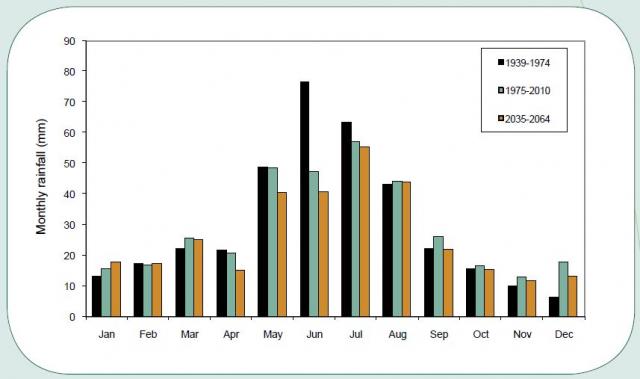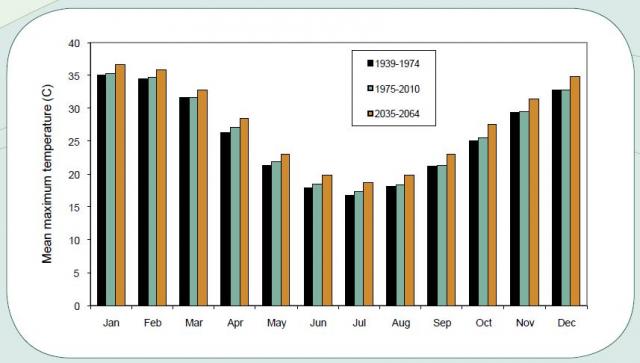Why this information is important
Climate change and climate variability have already affected Western Australian (WA) broadacre crop and animal production. Producers have been able to meet these challenges by adopting innovative farming systems to maintain farm profitability and sustainability. Future climate change will present further opportunities and challenges for producers.
Records show that rainfall decreased and temperatures increased over the last century. Climate projections for the south-west of WA are for declining rainfall and higher temperatures.
The grainbelt of WA contributes more than $4.5 billion to WA’s economy per year. Dalwallinu is 220 kilometres north-east of Perth on the eastern edge of the northern grainbelt. This agri-climate profile provides an analysis of records and projections for a range of climate variables relevant to farm businesses in the Dalwallinu area.
Changes at a glance
The observed trends in Dalwallinu’s climate include:
- little change to annual rainfall
- a decrease in growing season rainfall (smaller and less frequent rainfalls)
- a decrease in the number of heavy rainfalls in winter
- an increase in summer rainfall
- an increase in the number of heavy rainfalls in summer
- fewer very wet years
- more-variable and later break of season
- an increase in average maximum and minimum temperatures.
What the records show
There were shifts in climate for Dalwallinu in the mid-1970s, then again around 2000. Therefore the analysis is for 1931–1974 (43 years), 1975–2018 (43 years) and 2000–2018 (18 years).
Rainfall
Total annual rainfall in 1975–2018 decreased by 3%, compared to 1931–1974.
Growing season rainfall (April–October) has declined by 10% since the mid-1970s and a further 15% since 2000 (Figure 1).
The chance of two consecutive drought years (decile 3 growing season rainfall or below) has increased from 5% in 1931–1974 to 14% in 1975–2018.
Around the mid-1970s there was a shift to consistently drier winter conditions. Figure 2 shows a significant decline in June rainfall and a significant increase in December rainfall in 2000–2018, compared to 1931–1974.
Figures 3 and 4 show the rainfall reduction during June has resulted from a combination of fewer days with heavy rainfall (greater than 5 mm) and fewer days with any rain. The increase in summer rainfall has mainly resulted from more rain during December and January.
Temperature
Since the mid-1970s, mean monthly maximum temperatures significantly increased during April–July and have remained largely unchanged during the rest of the year (Figure 5).
Average monthly minimum temperatures have remained largely unchanged (Figure 6).
The number of days with maximum temperature above 35 degrees Celsius (˚C) did not significantly change (Figure 7).
The number of frost days – days with minimum temperature below 2˚C – significantly increased in July and September. The average date of the last frost was 20 August in 1931–1974 and 13 August in 1975–2018. A frost risk for cereal crops around flowering remains (Figure 8).
Projected changes
The following projections for 2035–2064 were obtained using an intermediate-emissions scenario (A2) and downscaled data from the CSIRO Global Climate Model CCAM (CMIP3).
Rainfall
Projections are that rainfall will decrease in autumn-winter and increase in summer (Figure 9).

Temperature
Projections are that average monthly maximum temperatures will increase (Figure 10).

What are the agronomic implications?
- Since 1939, the start of the growing season has remained unchanged. The average break of the season, derived from a sowing rule that uses a sowing window starting from 25 April, shifted from 21 May for 1931–1974 and 1975–2018, to 22 May In 2000–2018.
- Later and more variable break of season will increase production risk for crops and pastures. Declining autumn rainfall means crops need to be established at the earliest opportunity, possibly with dry seeding. Conservation of out-of-season rain is gaining importance. Effective control of summer weeds and stubble is becoming more important.
- The decline of heavy rainfall events in winter has reduced the reliability of run-off into farm dams.
- Declining growing season rainfall and the occurrence of lighter rainfalls has led to greater proportional evaporation losses and less water stored deep in the soil. This increases the risk of moisture stress during crop estanlishment, flowering and grain fill.
- Declining winter rainfall will reduce pasture production. Flexible lot-feeding or confined-feeding systems may need to be established to maintain or finish stock in dry years. Perennial pastures and native pastures should be investigated as a possible alternative to annual pastures.
What are the options for adapting to climate change?
We provide information and technical support for making changes at the incremental, transitional and transformative levels. A general guide is available for each major enterprise and for soil and water resources:
